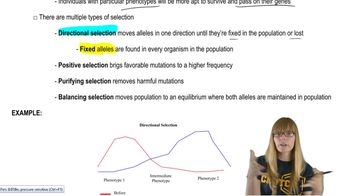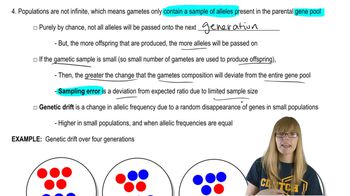Table of contents
- 1. Introduction to Genetics51m
- 2. Mendel's Laws of Inheritance3h 37m
- 3. Extensions to Mendelian Inheritance2h 41m
- 4. Genetic Mapping and Linkage2h 28m
- 5. Genetics of Bacteria and Viruses1h 21m
- 6. Chromosomal Variation1h 48m
- 7. DNA and Chromosome Structure56m
- 8. DNA Replication1h 10m
- 9. Mitosis and Meiosis1h 34m
- 10. Transcription1h 0m
- 11. Translation58m
- 12. Gene Regulation in Prokaryotes1h 19m
- 13. Gene Regulation in Eukaryotes44m
- 14. Genetic Control of Development44m
- 15. Genomes and Genomics1h 50m
- 16. Transposable Elements47m
- 17. Mutation, Repair, and Recombination1h 6m
- 18. Molecular Genetic Tools19m
- 19. Cancer Genetics29m
- 20. Quantitative Genetics1h 26m
- 21. Population Genetics50m
- 22. Evolutionary Genetics29m
1. Introduction to Genetics
History of Genetics
Problem 9
Textbook Question
What are the four processes of evolution? Briefly describe each process.
 Verified step by step guidance
Verified step by step guidance1
1. **Natural Selection**: This is the process where organisms better adapted to their environment tend to survive and produce more offspring. The theory of its action was first fully expounded by Charles Darwin and is now believed to be the main process that brings about evolution.
2. **Mutation**: Mutations are changes in the DNA sequence of a cell's genome and are a major source of genetic variation. They can be caused by various factors, including environmental influences and errors during DNA replication.
3. **Gene Flow**: Also known as gene migration, this is the transfer of genetic variation from one population to another. If the rate of gene flow is high enough, then two populations are considered to have equivalent genetic diversity and therefore effectively be a single population.
4. **Genetic Drift**: This is a mechanism of evolution that refers to random fluctuations in the frequencies of alleles from one generation to the next. It is most significant in small populations and can lead to the loss of genetic variation.
Recommended similar problem, with video answer:
 Verified Solution
Verified SolutionThis video solution was recommended by our tutors as helpful for the problem above
Video duration:
57sPlay a video:
Was this helpful?
Key Concepts
Here are the essential concepts you must grasp in order to answer the question correctly.
Natural Selection
Natural selection is the process by which individuals with favorable traits are more likely to survive and reproduce. This leads to the gradual adaptation of populations to their environments. Over time, advantageous traits become more common, while less beneficial traits may diminish, driving evolutionary change.
Recommended video:
Guided course

Natural Selection
Genetic Drift
Genetic drift refers to random changes in allele frequencies within a population, which can lead to significant evolutionary changes over time, especially in small populations. This process can result in the loss of genetic diversity and can cause certain traits to become more or less common purely by chance, rather than through natural selection.
Recommended video:
Guided course

Genetic Drift
Gene Flow
Gene flow, or gene migration, is the transfer of genetic material between populations through the movement of individuals or their gametes. This process can introduce new alleles into a population, increasing genetic diversity and potentially altering the evolutionary trajectory of the population by making it more adaptable to changing environments.
Recommended video:
Guided course

Mapping Genes

 11:35m
11:35mWatch next
Master History of Genetics with a bite sized video explanation from Kylia Goodner
Start learningRelated Videos
Related Practice


